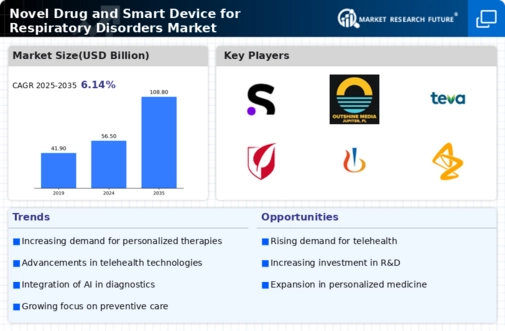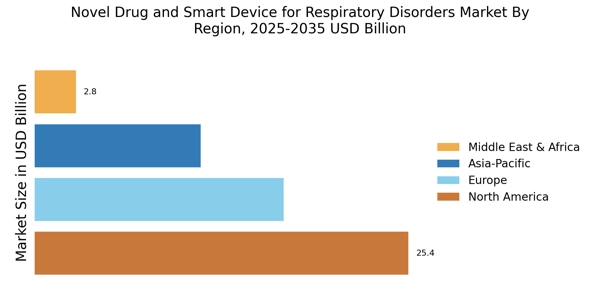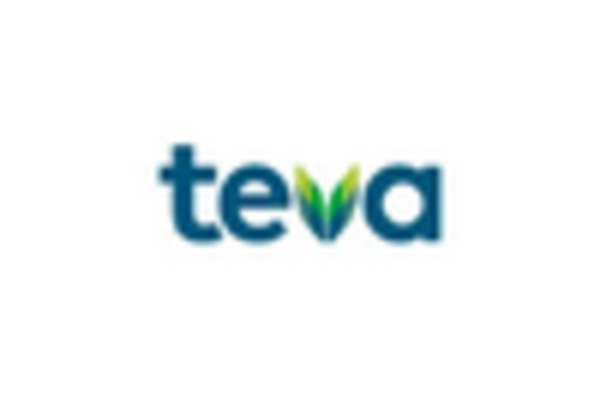Rising Prevalence of Respiratory Disorders
The increasing incidence of respiratory disorders, such as asthma and chronic obstructive pulmonary disease (COPD), is a primary driver for the Novel Drug and Smart Device for Respiratory Disorders Market. According to recent estimates, respiratory diseases affect millions of individuals worldwide, leading to a heightened demand for innovative treatment options. This surge in prevalence necessitates the development of novel drugs and smart devices that can effectively manage symptoms and improve patient outcomes. The market is projected to witness substantial growth as healthcare providers seek advanced solutions to address the growing burden of respiratory conditions. Furthermore, the integration of smart devices into treatment regimens is likely to enhance patient adherence and monitoring, thereby contributing to the overall expansion of the market.
Regulatory Support for Innovative Therapies
Regulatory bodies are increasingly supporting the development of innovative therapies for respiratory disorders, which serves as a key driver for the Novel Drug and Smart Device for Respiratory Disorders Market. Initiatives aimed at expediting the approval process for novel drugs and devices are encouraging pharmaceutical companies to invest in research and development. Programs such as breakthrough therapy designations and fast-track approvals are designed to bring effective treatments to market more quickly. This regulatory environment fosters innovation and encourages the introduction of cutting-edge solutions that address unmet medical needs in respiratory care. As a result, the market is poised for growth as new therapies and smart devices gain regulatory approval and become available to patients.
Growing Demand for Home Healthcare Solutions
The shift towards home healthcare solutions is a significant driver for the Novel Drug and Smart Device for Respiratory Disorders Market. With an increasing number of patients preferring to manage their health conditions at home, there is a rising demand for smart devices that facilitate remote monitoring and treatment. Devices such as portable nebulizers and smart inhalers are becoming essential tools for patients with respiratory disorders, allowing for convenient and effective management of their conditions. This trend is further supported by the aging population, which often requires ongoing respiratory care. The market is likely to see continued growth as healthcare systems adapt to this demand, focusing on providing accessible and user-friendly solutions that empower patients to take control of their health.
Technological Advancements in Drug Development
Technological innovations in drug development are significantly influencing the Novel Drug and Smart Device for Respiratory Disorders Market. The advent of advanced biopharmaceuticals and novel drug formulations has revolutionized the treatment landscape for respiratory disorders. Techniques such as high-throughput screening and artificial intelligence are streamlining the drug discovery process, enabling faster and more efficient development of effective therapies. Additionally, the emergence of smart inhalers and connected devices is enhancing drug delivery and patient engagement. These advancements not only improve therapeutic outcomes but also foster a more personalized approach to treatment. As a result, the market is expected to expand as pharmaceutical companies invest in research and development to bring innovative solutions to patients suffering from respiratory ailments.
Increased Awareness and Education on Respiratory Health
There is a growing awareness and education regarding respiratory health, which is driving the Novel Drug and Smart Device for Respiratory Disorders Market. Public health campaigns and educational initiatives are informing patients about the importance of early diagnosis and effective management of respiratory disorders. This heightened awareness is leading to increased patient engagement and a greater willingness to seek treatment. As patients become more informed about their conditions, they are more likely to utilize novel drugs and smart devices that can enhance their quality of life. The market is expected to benefit from this trend as healthcare providers and organizations continue to promote respiratory health education, ultimately leading to improved patient outcomes and increased demand for innovative solutions.


















Leave a Comment